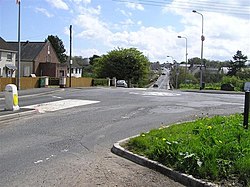Coagh: Difference between revisions
No edit summary |
No edit summary |
||
| Line 1: | Line 1: | ||
{{Infobox town | {{Infobox town | ||
|name=Coagh | |name=Coagh | ||
|county=Tyrone | |county 1=Tyrone | ||
|picture= | |county 2=Londonderry | ||
|picture caption= | |picture=Tamlaght, Coagh.jpg | ||
|os grid ref= | |picture caption=Towards the village from the Londonderry side | ||
|LG district= | |os grid ref=H892786 | ||
|latitude=54.6477 | |||
|longitude=-6.6184 | |||
|population=545 | |||
|census year=2001 | |||
|post town=Cookstown<br>Magherafelt | |||
|postcode=BT80; BT45 | |||
|dialling code=028 | |||
|townland= | |||
|LG district=Mid Ulster | |||
}} | }} | ||
'''Coagh''' is a village in [[Tyrone]]. | '''Coagh''' is a small village and townland in [[Tyrone]], five miles east of [[Cookstown]]. Part of the village also extends across the river into [[County Londonderry]]. Coagh stands on the Ballinderry River, which here marks the county border. | ||
The village is within the Barony of [[Dungannon Upper]]. It is a small place: it had a recorded population of 545 at the 2001 Census. | |||
[[File:Coagh Bridge.jpg|right|thumb|200px|The bridge in Coagh]] | |||
The village owes its existence to George Butle Conyngham of [[Springhill, County Londonderry|Springhill]], and was founded in 1728 when King George II granted Conyngham a market charter allowing the village to host four fairs yearly.<ref>{{cite web|url=http://www.proni.gov.uk/introduction__lenox-conyngham_papers.pdf|title=Public Record Office of Northern Ireland (PRONI) - nidirect|date=4 March 2016|website=proni.gov.uk|access-date=12 April 2018}}</ref> | |||
The name of the village much earlier than the new town charter, coming from the Gaelic ''An Cuach'', meaning 'The hollow'.<ref>{{placenamesNI|5867|Coagh}}</ref> | |||
==About the village== | |||
The village nestles among gentle, low-lying land between the [[Sperrins]] and [[Lough Neagh]]. The main feature of the village is Hanover Square, which was named by Conyngham after King George's House of Hanover. | |||
The village has been an ancient settlement for several thousand years; overlooking Coagh is the Tamlaght Stone, a Mesolithic dolmen erected c. 4500 BC. | |||
==Sport== | |||
*Football: Coagh United F.C. | |||
==See also== | ==See also== | ||
*[[Coagh Bridge]] | *[[Coagh Bridge]] | ||
{{ | {{commons}} | ||
==References== | |||
{{reflist}} | |||
Latest revision as of 13:54, 30 November 2022
| Coagh | |
| Tyrone, County Londonderry | |
|---|---|
 Towards the village from the Londonderry side | |
| Location | |
| Grid reference: | H892786 |
| Location: | 54°38’52"N, 6°37’6"W |
| Data | |
| Population: | 545 (2001) |
| Post town: | Cookstown Magherafelt |
| Postcode: | BT80; BT45 |
| Dialling code: | 028 |
| Local Government | |
| Council: | Mid-Ulster |
Coagh is a small village and townland in Tyrone, five miles east of Cookstown. Part of the village also extends across the river into County Londonderry. Coagh stands on the Ballinderry River, which here marks the county border.
The village is within the Barony of Dungannon Upper. It is a small place: it had a recorded population of 545 at the 2001 Census.

The village owes its existence to George Butle Conyngham of Springhill, and was founded in 1728 when King George II granted Conyngham a market charter allowing the village to host four fairs yearly.[1]
The name of the village much earlier than the new town charter, coming from the Gaelic An Cuach, meaning 'The hollow'.[2]
About the village
The village nestles among gentle, low-lying land between the Sperrins and Lough Neagh. The main feature of the village is Hanover Square, which was named by Conyngham after King George's House of Hanover.
The village has been an ancient settlement for several thousand years; overlooking Coagh is the Tamlaght Stone, a Mesolithic dolmen erected c. 4500 BC.
Sport
- Football: Coagh United F.C.
See also
| ("Wikimedia Commons" has material about Coagh) |
References
- ↑ "Public Record Office of Northern Ireland (PRONI) - nidirect". 4 March 2016. http://www.proni.gov.uk/introduction__lenox-conyngham_papers.pdf.
- ↑ Coagh - Placenames NI
